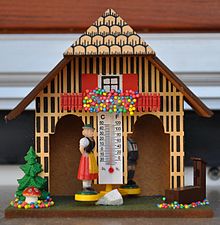Weather house (hygrometer)
A weather house is a hygrometer in the form of a two-door miniature house, which reacts to the humidity through a simple mechanism and is supposed to display the weather with the help of movable figures .
functionality
The weather house is a traditional form of the hygrometer in which, depending on the humidity, one of two figures looks out of the house while the other disappears into it. Usually the woman (“sun woman”) stands for good weather , the man (“rain man”, often shown with an umbrella ) for bad weather . For this purpose, the figures are attached to a rotatable disc that is pulled in one direction by a spring. A piece of animal intestine ( gut string ) or a strand of hair (usually horse hair), which reacts strongly to the moisture, provides the counterforce and actual deflection . For a weather house to function properly, it must be installed outdoors.
Many weather houses also have a thermometer attached, making them a forerunner of the weather station .
history
Jacob Leupold described such a hygrometer in his Theatrum Aerostaticum in 1726 , which he had made many years earlier. The Zedler Lexicon reported in 1735 that such instruments were sold by barkers . In 1795, Karl Friedrich August Hochheimer refrained from providing a more detailed description of the weather houses in his general economic-chemical-technological house and art book in the instructions for the manufacture of hygrometers, since you can see them “everywhere for yourself”.
Individual evidence
- ↑ Jacob Leupold : Theatrum Aerostaticum, or: Show place of the machines For weighing and observing all the most distinguished properties of the Lufft. (= Theatrum Machinarum , Volume 5.3). Leipzig 1726, p. 290 , panel XIV, figures I. and II.
- ^ Hygrometrum. In: Johann Heinrich Zedler : Large complete universal lexicon of all sciences and arts . Volume 13, Leipzig 1735, column 1422.
- ^ Karl Friedrich August Hochheimer: General economic-chemical-technological house and art book or collection of selected regulations for use by housekeepers and farmers, professionalists, artists and art lovers . Leipzig 1795, p. 276 ( full text in Google Book Search).
